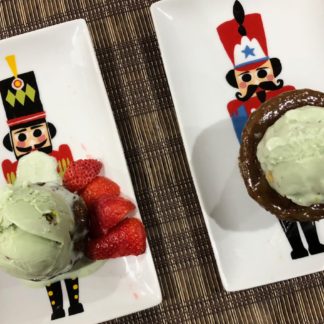
Aloo Gobi Singara Layered Bengali Samosa is traditionally known as Aloo Phulkopir Singara in Bengali. When I saw this image on the web, I was fully mesmerized by the flowing layer look atop one of the most famous Indian Snack- Samosas! It just made the samosas climb a new height in my eyes. I had been craving for Samosas and it being Diwali time, in most homes, the best and the most creative dishes are being cooked so was looking for a recipe that satisfied my creativity as well as craving for samosas.
Cauliflower stuffing mixed with the traditional potatoes, gives it a whole new taste and the traditional recipe even mixes in raisins and cashews which I avoided, as did not want a sweet taste in the singara. My exposure to Bengali samosas came from Tewari Brothers near Opera House in Mumbai, whose samosas are just simply amazing and different as they had Chhole filling in their samosas and were fried in ghee. Now interesting point to google would be did Singara came first or the Persian Sambosag
So while searching for that recipe, I came across the Aloo Gobi Singara which was definitely different in taste with an interesting look, so thought why not start the Diwali festivities with a new take on an all time favorite Samosas!! Addition of whole spices of fennel seeds, coriander seeds and cumin seeds as well as a good amount of aamchur and roasted cumin gives it a good depth and blends the cauliflower and potatoes into a nice tangy, spicy mix, and when fried in ghee, everything just becomes fragrant, My house reminded me of the aroma at Tewari Bros! In West Bengal, singara and samosas are two different items, primarily different in shape as the samosa are more triangular/flatter and can be filled with many other stuffings, but singara has to have potatoes and cauliflower in their stuffing and are more rounder with greater amount of stuffing inside it.
Singaras are popular tea time snacks or journey snacks and they were introduced in 13th or 14 century by central Asian traders who brought them along with them to eat and they often originally had meat and other stuffings in it. The Persians called them as Sanbosag, and the Bengalis nicknamed them as singara as it had close resemblance to the Shingoras(Chestnuts). Well that makes the Aloo Gobi Singara Layered Bengali Samosa an even more apt fall delicacy as it is named after Chestnuts! The taste was great and the shape, texture and crispiness even greater!! The recipe below is a mix of various recipes on Singara on the web, modified to suit my personal taste. It does take some time to take, but then no Diwali/Festivity recipe is without some effort!
As a Jain I am happy to share this, as its a recipe that only uses half the amount of potatoes, and which easily can be substituted by Green Bananas. The time to cook is slightly more than normal samosas, and one can even try this using pastry dough too!
Happy to share Aloo Gobi Singara Layered Bengali Samosa with you all and wishing everyone a Prosperous Dhan Teras!!
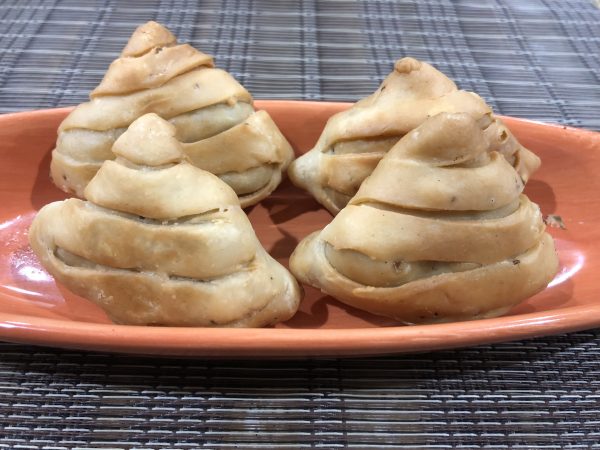
| Prep Time | 7 min |
| Cook Time | 1 hour |
| Passive Time | 30 min |
| Servings |
pieces
|
- 2 cups small florets of Cauliflower
- 1 1/2 cups Potato Cubes
- 1 tbsp oil
- 1 inch Ginger minced
- 3/4 pieces Thai Hot Green Chillies minced
- 1 tsp Whole Coriander to be coarsely grounded
- 1 tsp fennel seeds to be coarsely grounded
- 1/2 tsp cumin seeds to be coarsely grounded
- 1 tsp red chilli powder
- 1 tsp Roasted cumin powder
- 2 tsp Aamchur Dry Mango Powder
- 1 tsp Garam Masala
- 1/2 tsp turmeric powder
- 2 cups Maida or All Purpose Flour
- 4 tbsp Oil ( warmed for 20 seconds in microwave)
- 1/2 tsp carom or ajwain seeds
- 1/2 cup cold water
- 3/4Ghee cup ghee for frying the singara
Ingredients
For the Stuffing
For the Dough
|

|
- Mix in the flour, salt, carom seeds and oil thoroughly for about five minutes, till you see small lumps can form.

- After that add about half the water and combine thoroughly, then add the remaining water and knead the dough into a firm yet pliable consistency, slightly smoother than a pie dough.
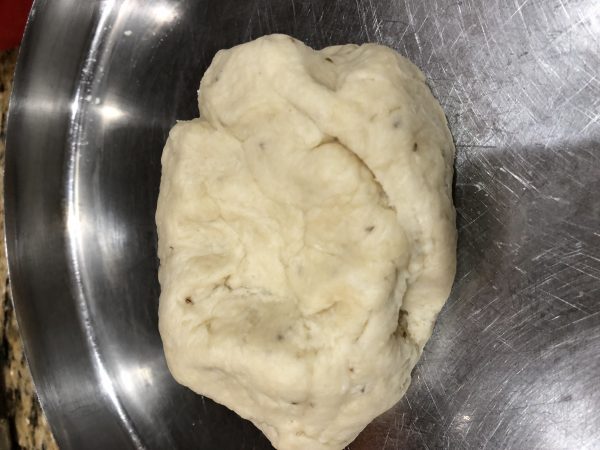
- Cover with a wet cloth for at least 30 minutes.

- Check for the gluten formation, by pressing fingers into the dough. If the dough bounces back, the gluten has formed.

- Divide the dough into twelve parts and make round balls.

- Heat the oil and add the coarsely grounded spices to it. Stir for a minute and then add the minced ginger and green chillies and stir further.

- Add cubed potatoes, mix and cover for 3 minutes to cook.

- Add cauliflower florets, turmeric powder and cover for 3 minutes and cook further

- Add salt , whisk the vegetables and cover and cook for another 5 minutes
- Add all the remaining spices and mix in two tbsp coriander, cook for 1 minute and remove from flame and let it cool.

- Roll one round ball into oval shape about 6 inches long.
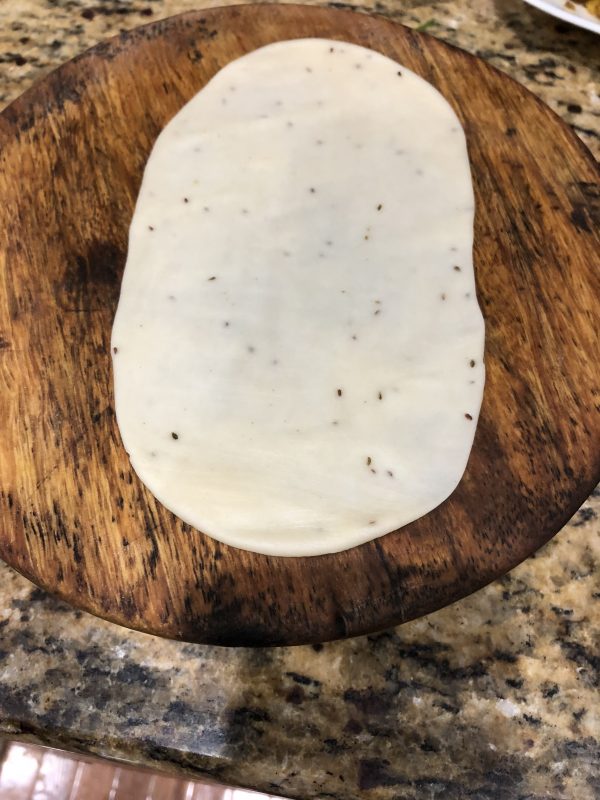
- Lightly fold the rolled dough into half and open again.
- Cut the oval into half, at the indicated half line present due to light folding.
- Using a pizza cutter or sharp knife make horizontal cuts across one half of the oval, about 1/2 inch apart, and also leaving a 1/4 inch border. Moisten with water all over the surface of this half

- Place the non-serrated/ plain half over the moistened cut/serrated half and align all the edges well.
- Bring the flat edged side on the top, curved side on the bottom, and also the cut side should be below, and plain half on the top. This way the cut side will become outer covering and plain side will be the inner side, when you fold the singara.

- Moisten the top flat edge with water.
- Lift from both the sides to make a V shape and pull one side over the other to close it in a cone shape.

- Press firmly where the two sides meet to ensure that it will be a tight bottom cone.

- Take 1 tbsp of stuffing and fill the inside of the cone.
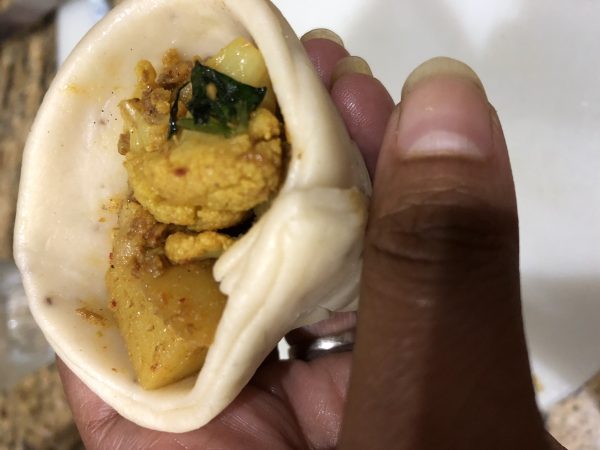
- Moisten the top open edge of the cone and bring it down horizontally to the lower side in order to close the cone. Make the rest of Singaras in the above manner.
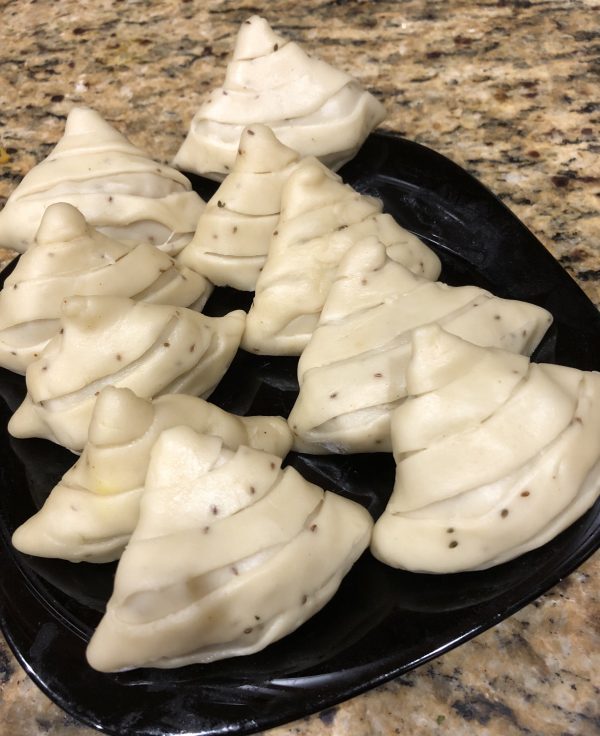
- Heat about 3/4 cup ghee in a flat pan.
- Once its hot, reduce it to slow flame. Add 4-5 Singaras to fry at a time on a low flame. Because you are frying in ghee, it will take time.
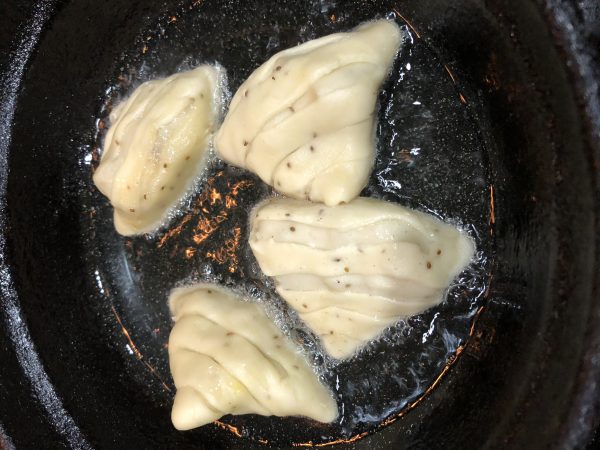
- Turn over and fry till they are evenly cooked and have an almond color texture. Remove from flame on to a paper towel to remove excess ghee.
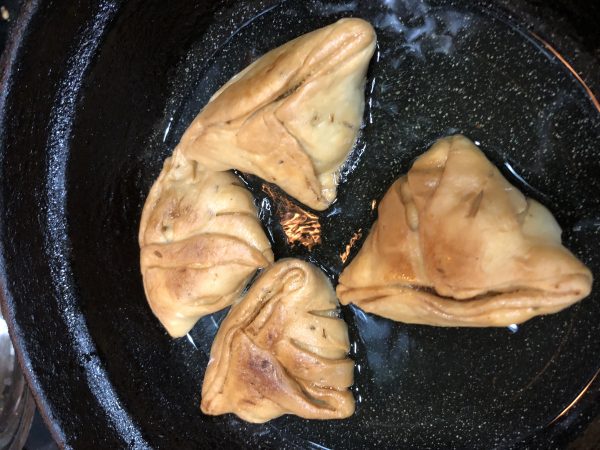
- Garnish it with some chat masala and serve hot with tamarind chutney/ green chutney or sauce.
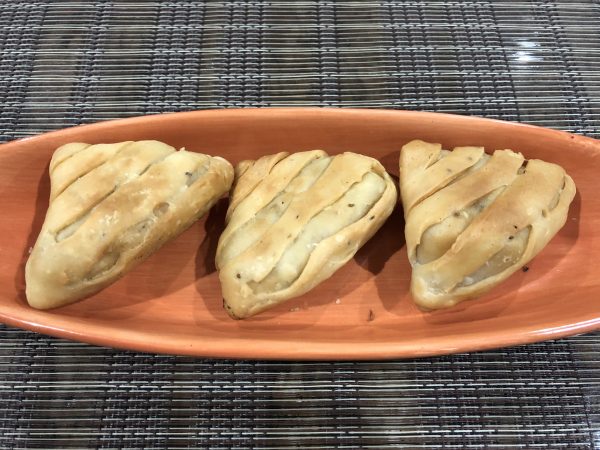

Tips
Ensure that the water for the dough is cold, and oil is warmed up. This is crucial to the dough. The consistency of dough is key to having a crispy texture to singara.
If frying in oil, the color of singaras, will be more golden as compared to when frying in ghee. The taste is much better when fried in ghee for sure. Make sure that the strip layer as well as the inside layer are well fried. Frying in ghee will take a little longer then frying in ghee.
Add 1/2 cup of peas for more flavor.
The simpler non layered version will be a much faster version of this!
Instinct Factor
Frying in ghee was an instinct based response, as I remember clearly that Tiwari Bros had an aroma of ghee at their shop and they are known to make everything in pure ghee. Having ghee also reduces acidity!
Feel Factor
Welcoming Diwali with something new, tasty, and as interesting as Aloo Gobi Singara Layered Bengali Samosa is a great way to feel happy about the festive joyous occasion! The tangy taste of the Aloo Gobi and the crispy and crunchy texture with the buttery feel due to frying in ghee, makes it a great festival recipe! It makes it unique and definitely an item when you want to impress someone with your culinary skills, and can be done in the more or less the same amount as when making the traditional samosas! Layered look gives it gourmet look so definitely a recipe to go for when you need some surprise element in your menu and a recipe that delivers!

